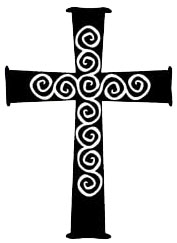|
The Rev. Frank Logue
Joy and Wonder in Disbelief First, a question. How many balls of string would it take to reach from here to the moon? The answer is one, if the ball of string is big enough. Silly, I know. But not pointless. For the question is what does it take for someone to believe that Jesus is the Son of God? How much evidence does it take? The answer for this question is the same as the ball of string. It may only take one piece of evidence, if that evidence is convincing enough. I begin this way as the disciples are, in our Gospel reading for today, still trying to decide what to believe about Jesus’ resurrection. In the reading, it is Easter evening. Some of seen the empty tomb, some have even seen their risen Lord, but most of the disciples are remain locked in an upper room in Jerusalem for fear of persecution as a follower of Jesus. Those who had seen the risen Jesus were telling others of their experience, and just then, Jesus appears among them in the locked room and says, “Peace be with you.” Luke tells us, “They were startled and terrified, and thought that they were seeing a ghost.” Many apparently view Jesus appearance in the only category they have available for a person who has died who now appears in a locked room. They do not yet all see Jesus as one who has conquered death, but view him as a ghost. So appearing among them was not enough for all to believe. So Jesus adds to the evidence saying, “Why are you frightened, and why do doubts arise in your hearts? Look at my hands and my feet; see that it is I myself. Touch me and see; for a ghost does not have flesh and bones as you see that I have.” Jesus wants the disciples to understand the reality of the resurrection. He will not remain with them always. He will return to the right hand of God the father. Jesus will once again transcend time and space as he did in the creation and through all time up until his being born in Bethlehem. But for now he stands before them bodily resurrected and he wants them to understand the miracle that has just occurred. Yet even this is not enough evidence for all of them. They know that Jesus is dead. Dead. Rome knows how to kill people, of this Jesus followers are certain. When Rome kills someone they are professional about it. And dead people stay dead. These facts are so well established that they are difficult to overcome. Jesus shows them his hands and his feet. This is the oddest fact of the resurrection, that Jesus still has wounds in his hands, feet and side. Jesus has risen from the dead wounded. It is astounding. After all, this is Jesus who could make a leper clean, he could give hearing to a man born deaf and sight to one born blind. Jesus who could feed the multitudes with a little bread and fish. Jesus who walked on water, calmed the storm, raised the dead. Jesus who could heal the centurion’s servant without even coming under his roof or stepping foot in his yard. Jesus who in so many ways had shown that his power was unlimited, chose to limit himself. Jesus didn’t use power to save himself from the cross. And here, Jesus who has been raised from the dead, comes back still bearing the marks, humanity’s marks, our marks, on his flesh. Jesus rises to new life as Henri Nouwen calls him, The Wounded Healer, one marked by the life he lived for us. This particular form of resurrection is significant. If Jesus rose all healed over, nice and neat, we could claim the cross as an inconvenient accident. We could decide that suffering, particularly suffering and sacrifice for others holds no meaning for us. But Jesus’ return still bearing the marks of the cross mean that we can not dispense with Good Friday. The one who could heal others with a touch leaves his own wounds raw and open and in so doing gives the disciples yet more cause to understand that this is no apparition. This is the resurrected Jesus standing before them. Yet even this is not enough for all of them. Luke tells us, “While in their joy they were disbelieving and still wondering, he said to them, ‘Have you anything here to eat?’ They gave him a piece of broiled fish, and he took it and ate in their presence.” I love that line, that in their joy they were disbelieving and still wondering. The Bible is the most realistic of books. Luke wants us to understand that the disciples had doubts even at times when we would think they must have been certain. Here they are with Jesus standing before them in the flesh offering the wounds of the cross for their examination and yet there is disbelief and wonder. If nothing else, this makes room for doubts within the church. We know that the disciples not only had doubts, but they were unafraid to let others know, for it was through their own teaching later and life that these stories of the disciples’ doubts entered in to scripture. Those first followers of Jesus want us to understand that there were times when what Jesus was doing was a bit too much for them to take in as well. They were amazed when he fed the multitudes, but then thought it was a ghost when he walked out to them on the water. And now they feel joy at seeing and hearing Jesus again but it leaves them with disbelief and wonder for it seems too good to be true. And so Jesus eats fish in front of them as a sure sign of his bodily resurrection. This bodily resurrection is a central teaching of Christianity, yet many believe in practice in a spiritual resurrection, the idea that only our souls continue. I have no problem with that idea, as far as it goes, except it is not what scripture teaches. The Bible tells us that Jesus rose from the grave in a resurrection body and that we too will rise, not to live in an old, worn out or mangled human body, but in a resurrected body that the Bible does not describe, but tells us that bodily resurrection matters. The author, John Updike, has a poem that captures the essence of this bodily resurrection. It is his Seven Stanzas at Easter:
Seven Stanzas at Easter Bodily resurrection shows that we do not hold with a Buddhist belief that we join with all that is. Instead, as Christians we proclaim a bodily resurrection for Jesus and for ourselves and in that we show that our own particular existence will continue. We will remain distinct individuals after death and resurrection. Yet, in this we find one more peculiar fact about Jesus’ resurrection. It’s those wounds again. We don’t believe that we will rise in wounded bodies. The first Christians never feared that those who were killed by lions in the coliseum would somehow be less whole in heaven than those who died peacefully in their sleep. In I Corinthians chapter 15 and elsewhere when the Bible spells out more about bodily resurrection, the state of our bodies at the time we die does not bear on our resurrection life. So why the wounds on the risen Christ? Jesus rising as a wounded healer shows that the joy of Easter makes sense only through the pain and suffering of the cross. Jesus’ death and resurrection, like the rest of his life and ministry reveal that Christianity is not a spirituality that seeks to deny the world. We are not called away from our bodily existence to some spiritual experience. Rather Christianity is intimately tied to day to day existing. Even, or especially, the messiness of day to day existence. So we are called to live our bodily, daily existence, transformed by the presence of the risen Christ within us. And it is this presence of the risen Christ within us that is the ball of string long enough to reach the moon. For the evidence for Jesus’ resurrection is not something distant. The evidence for Jesus’ resurrection is that if you are open to Jesus and honest with yourself about what you experiencing, you will find that Jesus can touch your life. The Wounded Healer has risen never to die again. Jesus is here in this place and there with you in your heart. The proof of the resurrection comes in that presence. Open the door of your heart and let Jesus in. Ask Jesus to touch your wounded life with his hands that still bear the marks of what we humans did and yet remain open, reaching out in love. And let the wounded feet of Jesus walk beside you as you come up to the altar this morning and as you go back out into the world, wounded as you are but carrying within you the healing words and hope that bring life. Amen.
| |

